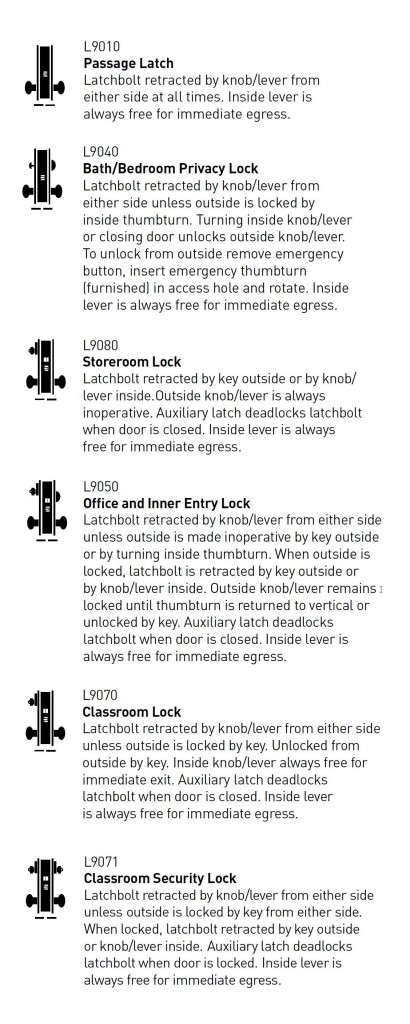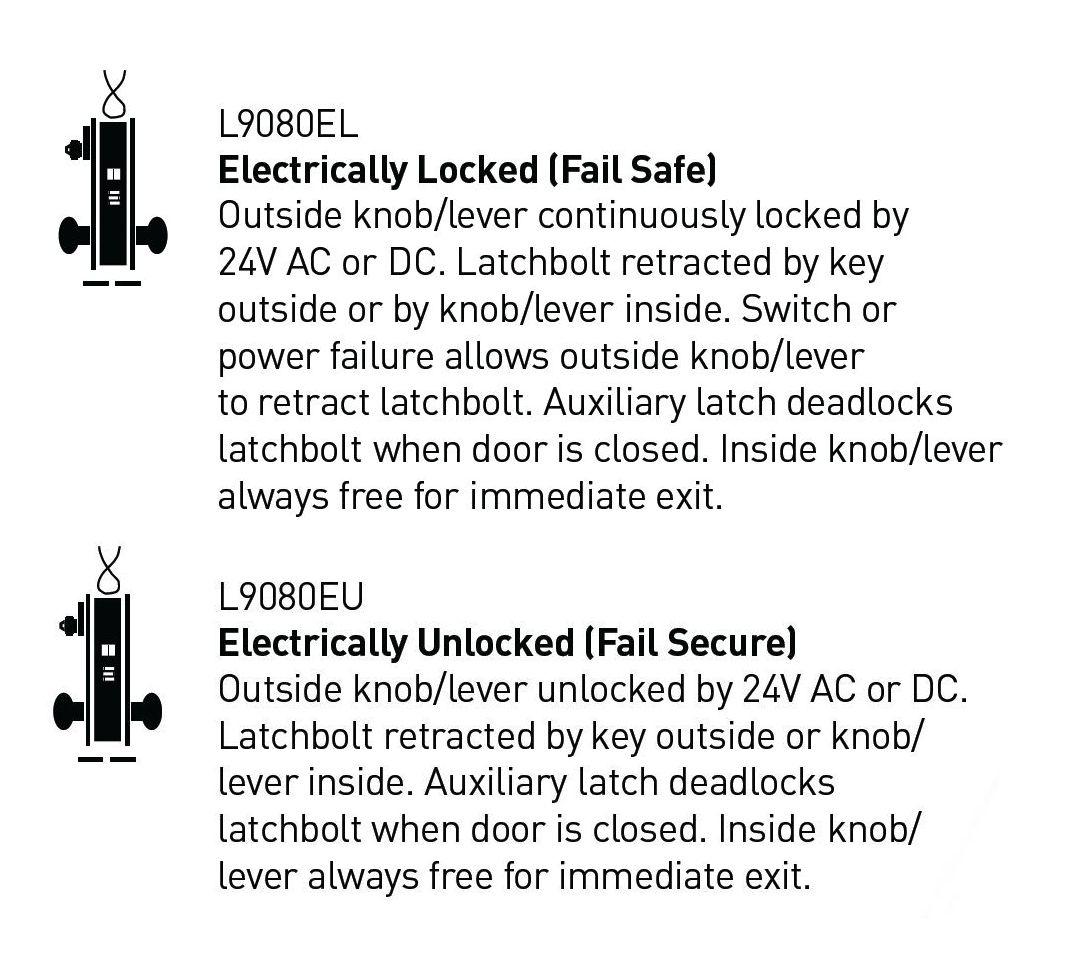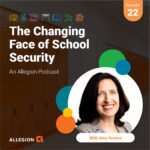When a hardware consultant writes a specification, it’s common practice to sit down and discuss the project with the architect, at least for the more complicated jobs. The topic of lock functions seems to arise at almost all of those meetings – usually someone in the room needs a refresher on how the basic functions work. In fact, when I was teaching our specwriter apprentices a few weeks ago I said, “Don’t ask the architect if he or she wants a storeroom function lock, ask if the door should always require a key to enter.” A manufacturer’s catalog may show 50 different lock functions (or more!) and it’s difficult or impossible to remember how each function works.
Luckily, there are 6 mechanical lock functions that account for the vast majority of locks specified. Add in a few deadbolt functions, and a basic understanding of electromechanical locks, and you’ve got the most common lock functions mastered! If a project requires a different lock function, our spec writers can help you decide which one to use.
The most common functions for mechanical locks are described below. Please note that all of these functions allow free egress at all times.
 Passage Sets are used where doors do not need to lock. There is no key cylinder and no means to lock a passage set.
Passage Sets are used where doors do not need to lock. There is no key cylinder and no means to lock a passage set.
Privacy Sets are used for restrooms or dressing rooms. They can be locked from the inside with a thumbturn or push button/turn for privacy, and they are typically unlocked from the outside using a tool rather than a key. There are several variations on this function, including a hospital privacy which has a thumbturn on both the inside and outside to allow hospital staff quick access to the bathroom. Some privacy functions may also incorporate an indicator to show the locked/unlocked status of the lock.
Storeroom Locks are used when the outside lever should be locked at all times. A key is used to retract the latchbolt and open the door; when the key is removed the door is locked on the outside. There is no means to lock/unlock the door from the inside. Typical locations for a storeroom lock would be secure storage rooms, mechanical rooms, and electrical rooms that do not require panic hardware. When a storeroom lock is specified, a door closer may also be needed to ensure that the door is not left open, defeating security.
Office Locks may be controlled by a key in the outside cylinder, or by a thumbturn or push button/turn on the inside. The outside lever may be left in a locked or unlocked position, and the use of the thumbturn/button provides convenience to the user, but may also allowed an unauthorized person to control the lock. This lock should be used where unauthorized use of the lock is not a concern – perhaps an individual office, or storage closet that does not need to be secured at all times.
Classroom Locks are controlled by a key in the outside cylinder, which locks or unlocks the outside lever. The lock can be left in the locked or unlocked state by using the key, and there is no means of locking or unlocking the door from the inside. This function was originally designed for schools, to prevent students from tampering with the lock, but most new schools have classroom security locks (see below). A classroom lock might be used for a common office corridor or suite entry, where key control of the lock is needed, and a thumbturn or push button/turn is not desired.
Classroom Security Locks allow control of the outside lever via key cylinders on both the inside and outside of the door. This allows a teacher to lock her classroom door during a lockdown event without opening the door and possibly being exposed to an intruder in the corridor, and in some jurisdictions these locks are required by law for school classrooms. The cylinder on the classroom side of the door does not prevent egress – it controls the outside lever, and is typically keyed so that all of the inside cylinders on classroom doors are operated by the same key, or are operated by any key in the school’s key system (“maison keying”). Classroom security locks are not restricted to classrooms, and can be used in any location where key-control of the outside lever is required from the inside of the room.
Deadbolts
Some doors may require the added security of a deadbolt, either combined in a mortise lock with one of the functions above, or as a separate lock. If a door is part of a means of egress, it must unlatch with one operation (with some exceptions for residential dwelling units), so deadbolts are often installed on doors with push/pull hardware. One example would be a door to a restroom with multiple toilet stalls, where the door would typically be push/pull (no lock) but may need to be locked if there is a plumbing problem.
Most deadbolts have a cylinder on the outside to project or retract the bolt. On the inside, there may be a thumbturn or key cylinder. If the door is in a means of egress (including the means of egress from a restroom), an occupant must be able to unlatch the door without a key, tool, or special knowledge or effort, so the applications for a key cylinder on the egress side are very limited. A thumbturn on the inside may freely project and retract the deadbolt, or in the case of a classroom function deadbolt the thumbturn will retract the deadbolt but not project it. A classroom function deadbolt prevents an unauthorized person from projecting the deadbolt to secure a room without permission, but provides for safe egress by allowing the thumbturn to retract the deadbolt if someone is accidentally locked inside the room by someone projecting the bolt with a key.
Electrified Locksets
There are various types of electrified products that can be used as part of an access control system. But electrified lock functions for mortise or cylindrical locks are actually fairly simple. There are two functions that are most commonly used – either electrically locked (fail-safe) or electrically unlocked (fail-secure). I’ll use the Schlage L9000 mortise lock functions to illustrate:
 L9080-EL is a function that is electrically locked (EL), or fail-safe. When electricity is applied to the lock, the outside lever is locked (inside lever always allows free egress). When electricity is removed from the lock, the outside lever is unlocked. The locking of the outside lever can also be controlled by a key that retracts the latch momentarily, but with an access control system it’s best to limit the use of keys. A fail-safe electrified lock is typically used when entry from the access side of the door is required during a fire; a stairwell door would be equipped with a fail-safe electrified lock to meet the stairwell reentry requirements. The outside lever of a fail-safe lock will be unlocked during a power failure, which impacts security.
L9080-EL is a function that is electrically locked (EL), or fail-safe. When electricity is applied to the lock, the outside lever is locked (inside lever always allows free egress). When electricity is removed from the lock, the outside lever is unlocked. The locking of the outside lever can also be controlled by a key that retracts the latch momentarily, but with an access control system it’s best to limit the use of keys. A fail-safe electrified lock is typically used when entry from the access side of the door is required during a fire; a stairwell door would be equipped with a fail-safe electrified lock to meet the stairwell reentry requirements. The outside lever of a fail-safe lock will be unlocked during a power failure, which impacts security.
L9080-EU is a function that is electrically unlocked (EU), or fail-secure. When electricity is applied to the lock, the outside lever is unlocked (inside lever always allows free egress). When electricity is removed from the lock, the outside lever is locked. The locking of the outside lever can also be controlled by a key that retracts the latch momentarily (again, should be limited for maximum control of the system). Fail-secure electrified locks are more common than fail-safe locks, as they provide security even when no power is applied. Most codes do not require the lever on the access side (outside) of the door to be unlocked during a fire alarm or power failure.
Conclusion
For questions about any of these lock functions, assistance with special applications, or a complete specification, Ingersoll Rand Security Technologies has more than 100 specification writers and architectural consultants available to help. We are also an AIA/CES approved provider, and conduct a wide range of courses offering AIA continuing education units. For help with code-compliance and product application, explore idighardware.com, where you can ask a specific question using the Help button.
Click here to download a PDF version of this article.
You need to login or register to bookmark/favorite this content.






Very good
Thanks Charles.
At my last job, the architect’s specs on lock functions were always way off. So I used the same tactic you described, I put it into simpler terms. e.g. ‘always locked, access by key only’, ‘locked or unlocked by button or key’, etc. It works!
Maybe the downloadable PDF will be helpful to someone trying to explain the functions. It always seems to come up.
One caveat in today’s world… When someone says “Classroom Lock” make sure to clarify how the customer would like it to function. The traditional “Classroom Lock” is sometimes mistaken for the “Classroom Security or Intruder function”
Good point, Sammy!
Can you please clarify what happens on classroom and classroom security lock when a peron leaves the room when the door is locked. Do they remain locked or are they now unlocked. This is the one bit of information that is missing from the catalog descriptions for all 50 functions. Some are obvious – storeroom types remain locked.
Hi Jack –
Most classroom locks and classroom security locks remain locked when the door is locked and someone leaves the classroom. For those you would need to use the key to change the status from locked to unlocked or vice versa. I’ve been told that some manufacturers’ classroom security locks unlock when you leave the classroom. I wouldn’t specify this application for a school classroom.
– Lori
Hi Lori:
To clarify, there are some mortise lock classroom security lock functions where the corridor side “unlocks” when someone leaves the classroom.
I also like to specify a door status indicator feature on classroom security functions.
Thanks, Jim
Hi Jim –
That seems like it would defeat the security, no? I will change my answer to Jack so nobody is misinformed, but can you send me an email with the name of the manufacturer(s) whose classroom security locks operate that way so I can look into it? lori.greene@allegion.com I agree with you on the indicator.
– Lori
Thanks Lori. This explains it very clearly.
Thanks Lori, for such a awesome website with lot of useful informations of codes and products.
You’re welcome!! Thanks for the compliment!
I prefer an office function lock (L9050) to be controlled by the thumbturn only. I am not in favor of the option that the key can lock/unlock the trim and the thumbturn can lock unlock the trim. We usually set them up with a different cam that will only retract the latch. I think the ANSI designation (F4?) describes locking/unlocking by way of a stopworks, not by way of a key.
To answer the classroom locking question, Schlage makes both models, one that will unlock as people exit the room (so the next class is not locked out) and one that stays locked. Both have the indicator on the inside of the door. I believe these are special order.
I have a question about classroom function locks (the regular kind, not with the lockdown feature like for Sandy Hook). I know the general features, there is always a free exit from the inside, and the outside can be put in a locked or unlocked mode by the key outside. I just need to know, with no thumbturn or cylinder inside, can a teacher say go out in the corridor, set it to lock, and then get back inside and say score tests, without students bothering her ? I know she will have a free exit anyway, it just isn’t apparent the way lock functions and deadbolt functions are explained, if the teacher can go to the corridor, set it to locked while holding the door open, then go inside and still shut the door.
In other words, I remember being in school and once we started a test, the teacher and us were in the classroom, but the guy who shows up 20 minutes late couldn’t open the door from the hallway. How does the teacher do that when there is no thumbturn or key cylinder outside ?
And in the function description, the statement says Auxiliary latch deadlocks latchbolt “WHEN DOOR IS CLOSED” . That makes it sound like the teacher or the head of an office suite can go into the corridor, hold the door “open”, use the key and set the key to locked, go back in the room, “close the door”, and when it closes it is locked, on one can get in (unless they have a key), and she can rest assured she is safe inside, and also has a free exit if there is a fire.
Hi Stuart –
Sorry for the delay…your question got caught in the spam filter for some reason. Yes – the teacher could lock the classroom function lockset and then go into the classroom and the outside lever would be locked. The auxiliary latch that is mentioned in the description of the function is part of the deadlatching (not a deadbolt or even an actual latch) – it prevents the latchbolt from being pushed in with a tool or credit card when the door is locked.
– Lori
There is no point that it is one of the best posts I have ever read regarding the basic lock functions. Nice guide!